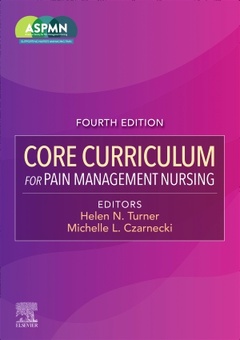Description
Core Curriculum for Pain Management Nursing (4th Ed.)
Language: English
Subject for Core Curriculum for Pain Management Nursing:
Keywords
<; p>; Core Curriculum for Pain Management Nursing 4th Edition; American Society for Pain Management Nursing; ASPMN; Helen N; Turner; Michelle L; Czarnecki; pain management; core curriculum; ASPMN pain management certification examination; pain management pharmacology; advanced practice nursing; perianesthesia nursing; oncology nursing; PACU; RN-BC credentialing exam; Starkweather Pain Management for Advanced Practice; Mometrix Pain Management Nursing Secrets Study Guide<; /p>
576 p. · 21.5x27.6 cm · Paperback
Description
/li>Contents
/li>
- Content written by ASPMN® ensures that information includes the latest in education, research, standards, and practice, as well as a thorough review for the ASPMN® certification exam and the RN-BC credentialing exam..
- Both pharmacologic and non-pharmacologic methods of pain management are described.
- Comprehensive coverage includes adult, pediatric, and geriatric patients along with key subsets of patients such as those who have concomitant addiction, those who have cancer, and those who are under sedation for a procedure.
- Wide-ranging content includes disparities in pain management, the roles of the clinical nurse specialist as well as the nurse practitioner, theories of pain management, the use of research, gender differences in how men and women respond to pain and analgesia, and the effect of depression on pain perception and management.
- Strong nursing focus provides guidelines for the nurse's role in pain management and in improving the quality of patient care.
- Easy-to-read outline format makes this book a quick and accessible reference.
- NEW! Updated content includes the latest changes in clinical practice including pharmacologic and non-pharmacologic pain interventions, integrative and complementary therapies, and the current ANA scope and standards of practice.
- NEW! Revised chapters include Mental Health Disorders and Pain and Managing Pain in the Context of Substance Use Disorder.
- NEW! Cannabis Use in Pain Management chapter is added to this edition.
- NEW! Reorganized content better highlights the complexity of assessment and management of pain.
- NEW two-color design, illustrations, and summary tables are added throughout the book, making difficult concepts easier to understand and remember.
Presidential Foreword
Where we've been and where we're going
Include Future of Pain here
Section One: Foundations of Pain Management Nursing (Sharon Wrona)
Chapter 1
Physiology of Pain
Sex/Gender differences
Pain and immunology
Genomics
Race and ethnicity
Types of pain
--Acute
--Persistent
--Acute on Persistent
--Nociceptive
--Neuropathic (CRPS)
--Mixed (arthritis)
Chapter 2
Current Pain Theories
Chapter 3
Mood Disorders and Pain (include peds)
Depression
Anxiety
PTSD
Trauma
Somatic Symptom Disorder
Chapter 4
Ethics, Disparities & Barriers Related to Pain Management
Diversity/Equity
Stigma
Opioid epidemic
Chapter 5
Impact of Pain and Benefits of Pain Management
Economic
Morbidity and mortality with pain
Diversity/Equity
Morbidity and mortality with treatment
Section Two: Nursing Roles in Patient Care and Beyond (Ann Schreier)
Chapter 6
Nursing Process
Assessment
Treatment
Evaluation
Education
Chapter 7
Research and Quality Improvement
Include QI methodologies
Chapter 8
Advocacy (include policy, governmental info)
Federal and state policy/regulations
Constantly changing
Chapter 9
APRNs in Pain Management Nursing
Prescribing
NP, CNS, CRNA, CNM
Section Three: Assessment (Ann Schreier)
Chapter 10
Introduction and General Concepts of Pain Assessment
Pain/suffering
Multidimensional assessment
Cultural considerations
Diversity/Equity
Chapter 11
Pain Assessment Tools
Pediatric pain assessment
Adult pain assessment
Assessment of cognitively Impaired and nonverbal adults
Chapter 12
Risk Assessments Related to Pain Management (substances, risky behavior)
Delirium
Withdrawal (COWs, WAT-1)
Opioid induced sedation (POSS, Ramsay, UMich)
--Who's at risk and monitoring
Risk assessment (substances, risky behavior)
Chapter 13
Mood, Sleep, Fatigue, Nutrition, and Eating Disorders
Section Four: Management (Maureen Cooney)
Chapter 14
Introduction and General Concepts of Pain Management Techniques
? WHO ladder (get the most current one or delete)
Multimodal therapy-general over view of drug classes
--Not specifics, that's in pharmacology
Acute pain guidelines
Opioid risk assessment
HHS guidelines
CDC guidelines
Cultural considerations
Diversity/Equity
Chapter 15
Integrative and Complementary Therapies
Chapter 16
Cognitve Therapies
CBT
Acceptance Therapy
Chapter 17
Pharmacology
Include all meds
Generic conversation about equianalgesic tables
Ketamine
Lidocaine
Beers Criteria
Medication weaning
PCA/AACA/RNCA
Reversal agents
Chapter 18
Cannabis
Chapter 19
Interventional Pain Management
Regional anesthesia/analgesia
--Peripheral and neuraxial nerve blocks
--Epidurals
--Wound infusions
Interventional techniques for persistent pain
--Implanted pumps
--Spinal and peripheral nerve stimulators
--Sympathetic blocks
--Joint injections
--Trigger point injections
Chapter 20
Procedural Sedation and Analgesia (include non pharm)
Emergent
Adult
--Bone marrows
--LPs
Pediatrics
--Circumcision
--Buzzy
--Sucrose
Chapter 21
Managing Complex Pain
General principles
Guidelines for various conditions--what are the best sources?
Common examples
-- MS pain (low back pain, fibromyalgia, arthritis, etc.)
--Abdominal pain
--Headaches
--Sickle cell disease
Interprofessional approach
Chapter 22
Managing SUD and Pain
Glossary of Terms
Index




